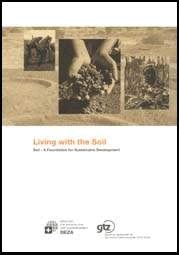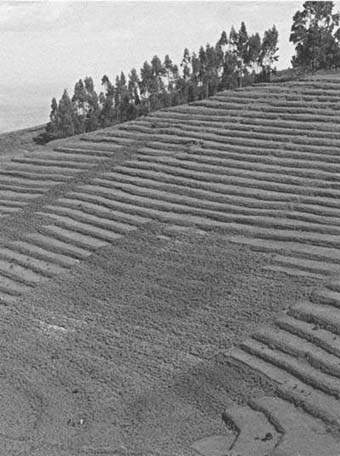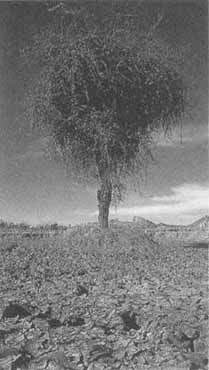
The Future[edit | edit source]
At present it remains extremely difficult to provide concrete answers to most of these questions. However, one fact will remain valid for a very long time to come: Ultimately, farmers themselves will decide whether measures produce positive, sustainable results. Will the terraces shown below continue to be levelled, or will they remain in place? This will depend largely on whether the labour required to maintain them is a profitable investment.
Growing conflicts over scarce resources
The strategic significance of soil will increase, and with it the risk of armed conflicts. Ominous signs of such developments are the wars in the Horn of Africa, and Central Africa (Rwanda, Burundi). Donor and partner countries will therefore need to make even greater efforts to protect scarce resources and increase soil productivity.
Soil protection through technical progress
Technical innovations enable farmers to till the soil on a more ecologically sound basis, and thus maintain and increase fertility. These innovations include conservation tillage or agriculture especially no - and minimum tillage technologies. These technologies will be adopted in primarily in situations where high labour and fuel costs make a reduction in production costs, coupled with the protection of soil resources, a sound economic option. They will also be adopted in regions where water causes soil erosion, and in semi-arid zones where low precipitation needs to be efficiently harnessed.
In dry regions, the use of organic substrates offers a further option for reducing wind erosion, and utilising low precipitation efficiently.
It is hoped that genetic engineering will deliver the means to breed varieties better adapted to acidic and nutrient-poor soils which are also drought-resistant.
Soil protection through more intensive utilisation
In the vicinity of expanding urban centres, the value of land is appreciating, thus making investment in the maintenance of soil productivity profitable. Easy access to inputs, and the utilisation of solid waste, or dung from chicken coops or pigsties, enable farmers to improve soil fertility. The harvested produce can be sold easily and at attractive prices on local consumer markets. Income generated through off-farm activity allows farmers to make investments in agriculture.
By contrast, in many densely-populated upland regions today the rising demand for land is already causing animal farming to diminish. This is leading to the collapse of traditional cropping systems, due to the growing scarcity of animal traction and farm manure. The result is a transition to a labour-intensive, horticulture-like form of small farming.
A return to traditional methods
In recent years, the failure of many imported methods has led to a return to traditional methods of soil conservation. This tendency will continue to increase, especially in marginal areas. The aim is not to reintroduce the old, but to blend old knowledge with new expertise, thus adapting it to the changed conditions. In arid zones, traditional methods can be revived and utilised more broadly for efficient water management (water harvesting) and the regeneration of degraded soils. In a number of areas in the Sahel region, such practices are already being successfully applied.
International soil convention
Soil is on the way to being declared an international protected good, analogous to the atmosphere and biodiversity. Governments are pledging to manage soils sustainably. Frameworks conducive to that end are being put in place. This applies both to soils used for forestry and agricultural purposes, and to infrastructure measures involving residential, industrial and traffic infrastructure. The Â"Convention to Combat DesertificationÂ" is just a first step in this direction, but soils in the humid tropics as well as in temperate climates needs to be protected, too.


